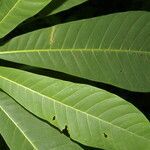Tree 10 m high. Leaves ? clustered toward the branch tips; petioles 1.2-4 cm long; blades obovate, often acuminate, 8-30 cm long, 4-13 cm broad, finely white-strigulose on the main veins beneath, sometimes also with a {ew similar hairs scattered over the lower and occasionally the upper surface, the primary laterals 12-20 pair, the secondary laterals regularly disposed, mostly perpendicular to the primary laterals, decidedly more conspicuous than the fine reticulum. Flow-ers clustered at defoliated nodes; pedicels ca 5 mm long; sepals ca 8, broad, densely appressed-grayish-sericeous dorsally except for thin glabrous margins, rounded or scarcely emarginate, spirally arranged, increasing the size centripetally, the largest ca 6 mm long; other flower parts unknown. Fruit ohovoid, fleshy, 8.5 cm long, 4.5 cm broad, yellowN-green, the surface irregularly wrinkled (at least in herbarium specimens) and also mealy-roughened; seed 1, obovoid. not compressed, 7 cm long, 3.5 cm broad, the scar obovate, basally acuminate. 3 cm broad, extend-ing the length of the seed, the seed-coat firm, shiny, yellowish-tan.
More
A tall tree. It grows up to 40 m tall. It can have small buttresses. The leaves are alternate and 14 cm long. They are stiff and narrow towards the base. They are bunched near the tips of the twigs. The flowers are cream coloured and 1 cm long. They occur in clusters along the twigs. The fruit is 7-12 cm long. It is green to brown with a warty texture. There are 1-2 seeds.


